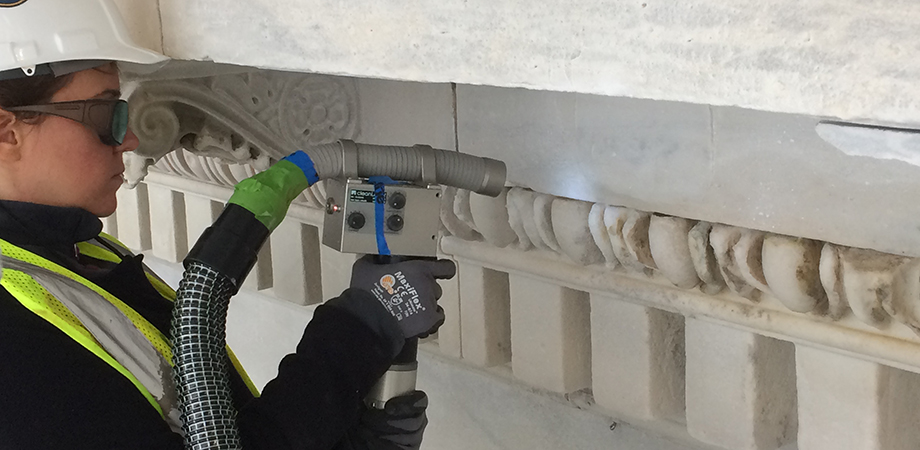Optics Does That? Giving Historic Objects a Laser Polish

The United States Capitol Building is an iconic part of the Washington, DC skyline. Two white marble wings flank a dome that is crowned by a larger-than-life statue of a woman titled "Freedom" who carries a sheathed sword and a laurel wreath. The first stone of the Capitol was laid in 1793 and the extensions of the marble wings were completed in 1868. Despite over 150 years of weather and city-related pollution, the building is a beautiful, pristine white that glistens in the sun on cloudless days.
Wonder how that's possible?
The answer is lasers. Lasers in the hands of conservators like Kelly Caldwell of EverGreene Architectural Arts, which uses 1064 nm Nd:YAG Adapt Laser and Powerlase systems to clean the Capitol and other buildings and sculptures throughout the United States. During her tenure at EverGreene, Caldwell has also been involved in cleaning such famous edifices as the Canadian Parliament in Ottawa and Columbia University in New York City.
The field of conservation in which Caldwell works encompasses much more than buildings and lasers. Conservation is about preserving historic objects, including structures like the Capitol, oil paintings, bronze sculptures, and artifacts unearthed at archaeological sites. And like lasers, conservation is a relatively new field. As Caldwell described it, at the turn of the twentieth century tradespeople such as carpenters, stone masons, and artists came together with academics from fields such as art history, architectural history, chemistry, and materials science to do the work of conservation. "The field itself is a melding of trade skills and academic background, and it is still like that today," said Caldwell.
Lasers were first used for cleaning stone in the 1970s, but "it wasn't really until the ‘90s that it became common. Institutes started really investigating their uses within the field of conservation," said Caldwell. Commercial laser technology became less expensive and more accessible, plus lasers began to offer a greater variety of output characteristics, allowing them to be used on a wider variety of materials, such as organics, textiles, plasters, and bronze.
But no matter what material is being cleaned, the goal is to remove impurities without altering the material itself. Conservators have a wide array of mechanical, chemical, and optical tools at their disposal, and knowing how each tool interacts with the material is critical for effective cleaning. "It always goes back to knowing what you are cleaning before you start...especially with lasers," said Caldwell.
Wavelength, pulse duration, and application methodology of the laser must be carefully selected and tested before cleaning. Laser cleaning works by breaking apart or vaporizing the impurity through absorption of the high-intensity light. This is why sulfate crusts on stone are such an excellent candidate for laser cleaning. The dark crust readily absorbs the 1064 nm light and is ablated off the white marble underneath, which reflects the light and is unaffected. However, the delicate surfaces of paintings are best cleaned with 248 nm excimer lasers. Organic impurities like mold and lichen have been found to respond well to 532 nm light.
But applied improperly, the laser light can alter the substrate, causing problems such as burning, pitting, or microstructural surface melting. "You may not see it, it may look to the visual eye that everything is stable, but microscopically it could have altered the material," said Caldwell. And changes like that can have negative or unforeseen long-term effects that cause degradation of the material over time.
Caldwell first learned how to use lasers working at the British Museum during her graduate studies. The museum required a "training course that focused on the mechanics and use of lasers, but specifically within the field of conservation," said Caldwell, "and it was taught by other conservators who had been working with lasers for numerous years." She said the hands-on portion was especially useful because it allowed her to "understand the feel, noises, and smells of the laser," as she operated it.
One of her favorite artifacts that she cleaned for the British Museum was an ancient Egyptian stele, a kind of stone marker, that had significant mold damage. Testing both 1064 and 532 nm laser light, she found the 532 nm wavelength was more effective for cleaning.
At EverGreene, Caldwell performs restoration, conservation, and design, as well as in-house research. Her research focuses primarily on materials characterization, and she uses certain optical characterization tools for it, such as polarized light microscopy. Conservation is an active field of ongoing research, and the International Institute for Conservation of Historic and Artistic Works even has a conference dedicated to Lasers in Conservation of Artworks, which has been running since 1995.
The field of conservation is a busy one. Tragic, landmark events like the burning of Notre Dame Cathedral in 2019 require massive restoration and conservation efforts. Damage caused by the increase in extreme weather events, such as flooding and fire, also creates a need for conservation. Modern construction materials used in buildings over the past century present new conservation challenges. This includes buildings in the concrete-heavy brutalist architectural style popular in the 1960s and 70s, some of which are considered historic and already in need of repair.
As the fields of conservation and optics continue to mature and expand, optical scientists and engineers will undoubtedly continue to provide conservators with novel, light-based tools to meet their needs.
So now you know. Conservation: optics does that.
Christina C. C. Willis is a laser scientist and writer living in Washington, DC, where she is currently serving on Capitol Hill as the 2019-2020 OSA and SPIE Arthur H. Guenther Congressional Fellow.
| Enjoy this article? Get similar news in your inbox |
|



